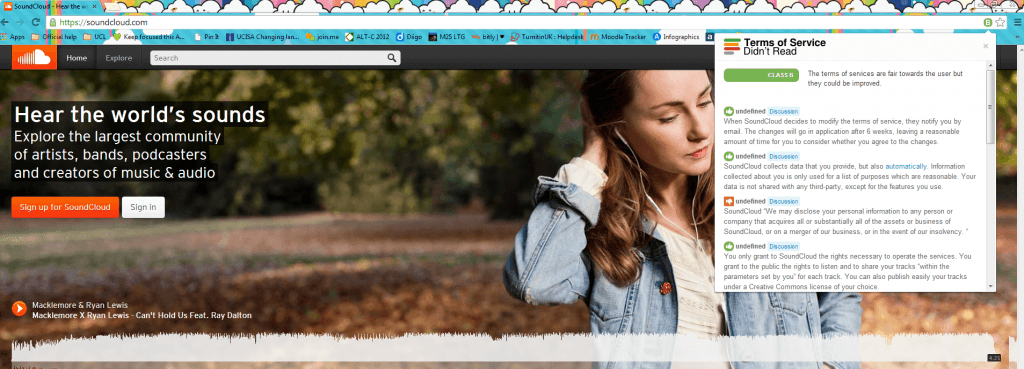Grounding the Cloud
By Clive Young, on 16 June 2014
 In April, Vicki Dale and Clive Young, E-Learning Environments carried out a survey with UCL teaching and support staff about their use of cloud-based tools for teaching, research, administration and personal use.
In April, Vicki Dale and Clive Young, E-Learning Environments carried out a survey with UCL teaching and support staff about their use of cloud-based tools for teaching, research, administration and personal use.
We wanted to find out if ELE should support any of these tools at all and if so to what extent, given the external and rather fluid nature of such services. Over 200 staff – mostly academic colleagues – responded to the survey from across UCL. We found evidence of use of a wide range of external cloud-based tools, many used personally, but also to support teaching, research and administration.
Although overall use was not as high as we had anticipated, some specific tools were used quite a lot. Skype was the most personally used technology (52%) while for teaching and research Dropbox was top (both 39%) and more than half of respondents had used Doodle for admin.
The top tools were:
| Purpose | Most used single tool | Average use (across teaching, research, admin and personal) | Mostly used for … |
| Filestore/file sharing | Dropbox | 43% | Personal (48%) |
| Video/voice calls | Skype | 37% | Personal (52%) |
| Event organisation | Doodle | 27% | Admin (54%) |
| Professional networking | 21% | Personal (36%) | |
| Social video sharing | YouTube | 21% | Teaching (33) |
| Short message broadcasting | 17% | Personal (24%) | |
| Social networking | 17% | Personal (42%) | |
| Online office tools | Google apps | 16% | Personal (17%) |
| Web conferencing & webinars | Skype | 16% | Research (19%) |
| Instant messaging | SMS texts | 13% | Personal (40%) |
| Filestore/file sharing | Dropbox | 43% | Personal (48%) |
| Video/voice calls | Skype | 37% | Personal (52%) |
| Event organisation | Doodle | 27% | Admin (54%) |
| Professional networking | 21% | Personal (36%) | |
| Social video sharing | YouTube | 21% | Teaching (33) |
| Short message broadcasting | 17% | Personal (24%) | |
| Social networking | 17% | Personal (42%) | |
| Online office tools | Google apps | 16% | Personal (17%) |
| Web conferencing & webinars | Skype | 16% | Research (19%) |
| Instant messaging | SMS texts | 13% | Personal (40%) |
It seems though that many of the tools are still only being used by enthusiasts, especially for professional purposes. This group could broadly be regarded as the self-starting ‘innovators’ and ‘early adopters’ (as identified in Rogers’ innovation curve), who are keen to experiment with new technologies without organisational support or encouragement.
Although not really surprising, this interpretation runs slightly counter to the popular notion that such tools are largely self-supporting and need little guidance. Nevertheless there may be a silver lining in this metaphorical cloud. Some tools are used much more for personal use and people are comfortable in using them. There could be the potential to adopt some of these tools for educational purposes.
We concluded that, firstly despite the hype around cloud-based tools and services, they are actually much like any other technologies. To increase their take-up, staff need to be provided with adequate support to work out what tools are appropriate to use and how they may be used in a professional context. Secondly, tools that we (as learning technologists) regard as ‘cool’ and cutting edge, may be seen by non-enthusiasts as unstable, unsupported and risky. We may have to rethink what tools and services we provide centrally. How can we provide the functionality of cloud-based tools that our colleagues evidently want for teaching, research and administration, but in a more supported and stable low-risk environment?
Image: dropbox.com
 Close
Close







